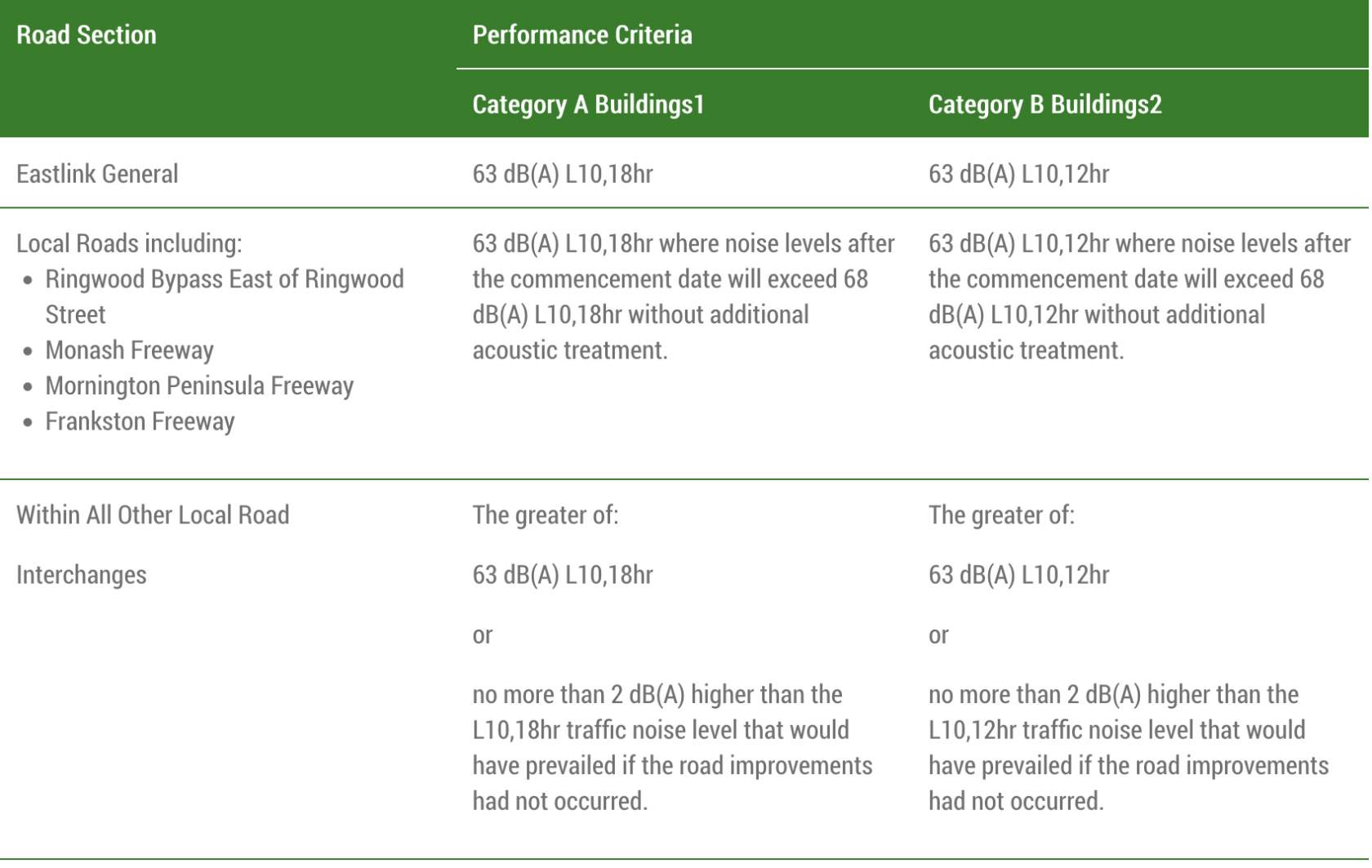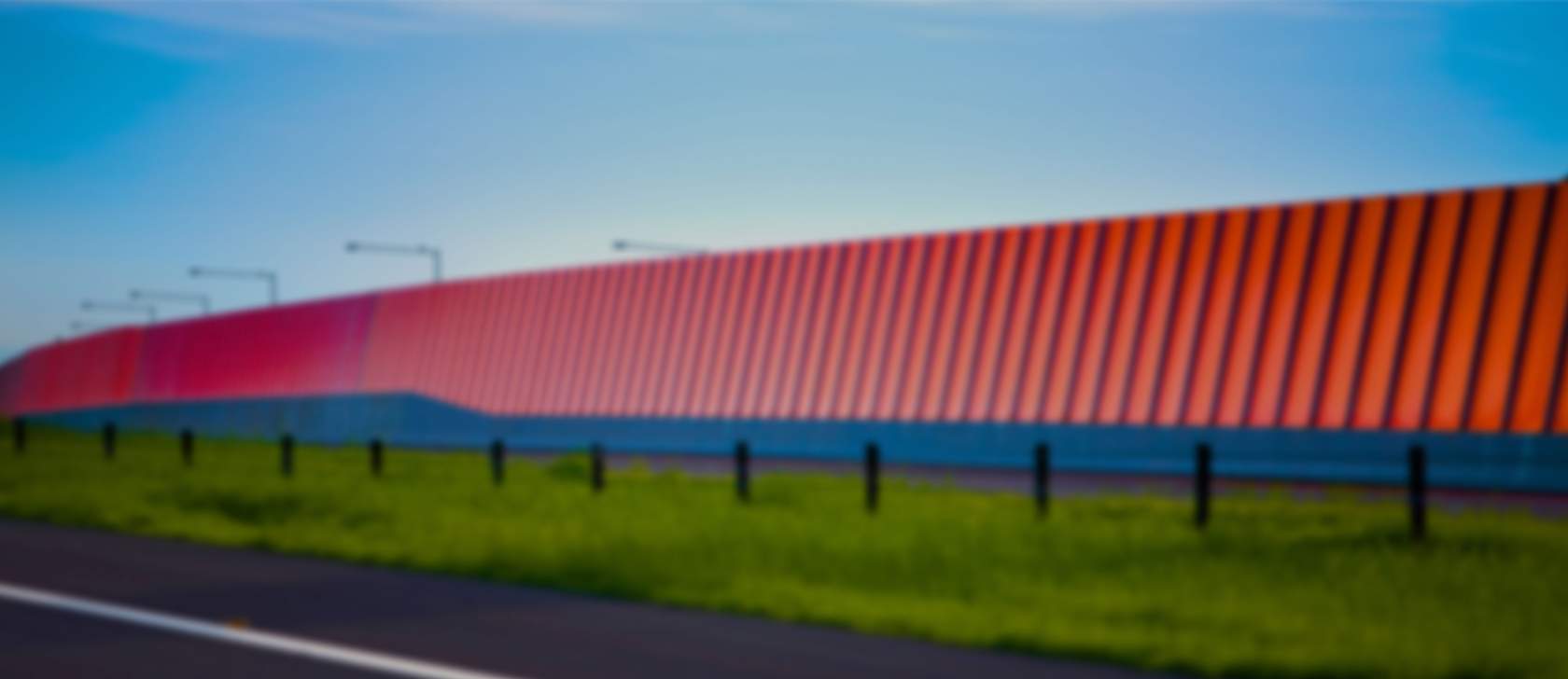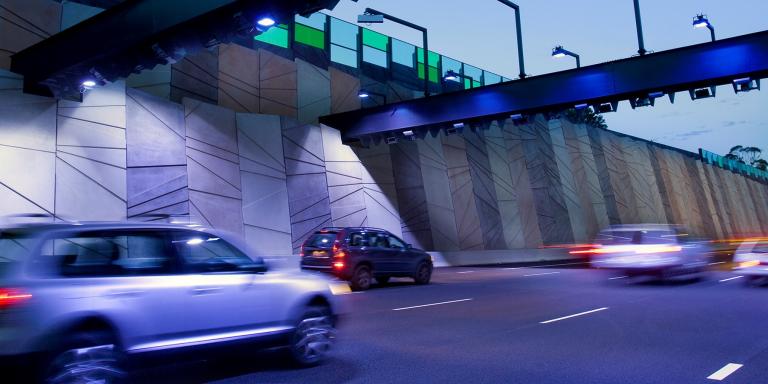
- Home >
- About EastLink > Air Quality & Noise Attenuation
Air Quality & Noise Attenuation
Tunnel ventilation system upgrade completed
In 2018 we completed the upgrade of EastLink's 10 tunnel exhaust fans to incorporate variable speed drives and a new automatic control system.
EastLink won the ITS Australia National Award for Industry in November 2018 for this upgrade:
Variable speed drives on fans allow the fans to operate at a more efficient lower speed than previously, saving power and reducing audible noise levels
The automatic control system monitors the output of the existing air quality and airflow sensors located within the tunnels, and based on those readings automatically controls the operation and speed of each exhaust fan
Prior to the upgrade, during the day, the exhaust fans expelled all tunnel air via the exhaust stacks with each fan running full speed, using a lot of power. An energy optimisation study conducted in 2014 found the 10 exhaust fans consume about 65% of the tunnel's total energy usage.
With lower fan speeds some air from the tunnels exits at road level with the air flow created by the flow of traffic within the tunnels. This air discharge at road level is known as portal emissions.
Previously, there were only portal emissions overnight when the ventilation system was turned off, and there were no portal emissions from the EastLink tunnels during the day.
To assist in achieving higher overall efficiencies, EPA Victoria has issued to EastLink a licence amendment to permit partial portal emissions of 1.5 meters per second (approx. 30%) from the tunnels during the day with 70% continued to be extracted out of the vent stacks. Air quality modelling and air quality monitoring following the upgrade has shown that EastLink is able to achieve all of its air quality criteria with a 30% portal emission during the day.
The upgrade has resulted in considerable direct energy savings, reducing greenhouse gas emissions by an estimated 9,000t CO2-e per annum, which is more than expected. The upgrade has also reduced audible vent stack fan noise in the adjacent community, which has been confirmed by noise testing.
Detailed information about EastLink's air quality and noise attenuation
In-tunnel air quality for the safety of motorists is ensured through the continuous monitoring of Carbon Monoxide (CO) and Nitrogen Monoxide (NO) as well as visibility.
The key factor influencing in-tunnel air quality is the emissions that are generated by the traffic using the tunnels. These vehicle emissions are affected by a number of factors such as the speed at which the traffic is travelling, the mix of vehicle types and the fuel used by those vehicles. In-tunnel air quality is also influenced by a number of other factors, including the quality of exhausts from vehicles, and the velocity of air moving through the tunnels.
The control of air quality within the tunnel is achieved by adjusting the numbers of fans to enable the rate of air flow through the tunnel to be varied according to the level of emissions in the tunnel. In essence, the higher the level of emissions in the tunnel, the higher the rate of air flow required in order to maintain an acceptable in-tunnel air quality. The tunnel ventilation system enables the specified in-tunnel air quality requirements to be met under all credible atmospheric and traffic flow scenarios.
Ventilation stack air quality
The EastLink tunnels' ventilation system comprises a ventilation station and stack at the exit of each of the tunnels, providing a separate ventilation system for each tunnel. The ventilation system works by fresh air being drawn in at the entry to the tunnels, with the flow of air induced by the flow of traffic, and with the assistance from ceiling mounted fans.
During the day, fans within the tunnel and in the ventilation stations enable the air to be extracted through a ceiling mounted vent and then discharged through the ventilation stacks.
Overnight, when traffic volumes are light and air quality is very good, air exits at road level.
The ventilation stacks house air quality sampling and monitoring equipment so that emissions into the local environment can be monitored.
One hour rolling average in-stack data for CO, NO2, PM2.5 and PM10 is provided daily.
Daily air quality charts
Air quality results are provided online daily via graphs showing the following information:
A line on each graph shows the EPA Licence Limit where applicable.
The graphs are updated each day. It should be noted that all emissions from the EastLink tunnels during normal operations (excluding emergency situations which may involve fire and smoke management) are via the stack and there are no emissions from the tunnel portals during these times:
Melba tunnel: 5am-8pm Mon-Fri; 7am-8pm Sat; 8am-8pm Sun and public holidays
Mullum Mullum tunnel: 6am-8pm Mon-Fri; 8am-8pm Sat, Sun and public holidays
All the data in published graphs are unvalidated. These data may be adjusted at a later time through a standardised procedure to account for instrument errors, power interruptions and the like.
View the most recent daily air quality charts here.
Quarterly air quality reports
Air quality monitoring reports prepared every 3 months are available for download. These reports include data results, analysis and assessments for ventilation stack monitoring stations.
Download quarterly air quality reports here.
Air quality breaches
In the event of a breach of EPA licence limits, the EPA will be notified immediately and a written report supplied within 7 days explaining the cause of the breach, action taken to address the breach and to avoid recurrence of the breach.
More than 13,000 noise wall panels have been installed along the length of EastLink. The noise barriers adhere to the overall visual themes for EastLink which are based on elements of the natural environment along the motorway’s alignment. These themes were previously applied to the award-winning noise walls built for the Eastern Freeway extension.
Pre-cast concrete panels comprise two types—a fractured pattern and a rock textured pattern— in either a charcoal-pigmented concrete or off-white pigmented concrete.
Transparent acrylic panels have been installed on bridges with smaller sheets of acrylic installed in concrete and acrylic composite noise walls. Orange and green acrylic panels have been used on bridges and interchanges.
In a small number of areas where there is sufficient space, landscaped earth mounds were used instead of concrete walls. Earth mounds provide the same level of noise reduction as walls.
The freeway reserve
EastLink has been constructed along an established freeway reserve in Melbourne’s east and south-east. The reserve was clearly detailed in Melways map directories for around 40 years before construction began.
This reserve minimised the number of houses that had to be acquired to make way for the motorway and also provided prospective purchasers of properties adjacent to the reserve with notice that it was the site for a major road in the future.
Noise monitoring
Shortly after the opening of EastLink, independent consultants Bassett Acoustics undertook a program of noise monitoring in representative locations along EastLink to measure the actual noise levels being experienced by residents.
Traffic noise criteria
The EastLink Concession Deed specifies the following performance criteria in relation to traffic noise:

Notes:
1 – Category A Buildings are defined as residential dwellings, aged persons homes, hospitals, motels, caravan parks and other buildings of a residential nature.
2 – Category B Buildings are defined as schools, kindergartens libraries and other noise-sensitive community buildings.
Noise Monitoring Methodology
Noise levels due to traffic on EastLink were measured at representative locations along the road corridor between Donvale and Frankston. The noise monitoring was undertaken more than three months after the opening of EastLink to measure the actual noise levels being experienced by residents.
An environmental noise logger was set up at each measurement location in general accordance with the procedures prescribed by “VicRoads Requirements for Acoustic Consultants”. The procedures require the microphone to be positioned outside a building, at a distance of one metre from the most exposed window to a habitable room on the lowest level of the dwelling. At each location, the measurements were performed for a period of nominally one week in terms of hourly ‘A’-weighted L10, L90, Leq and Lmax Sound Pressure Level.
The noise measurement locations were selected based on the following objectives:
Where the predicted noise level is close to the project criteria
Across a range of locations where different traffic noise model variables are introduced
At locations which are representative of where residents have raised concerns
At locations where the three different project criteria are applicable
Where different noise walls and barrier types are encountered
Visual inspection following a drive through
Results
The results of the noise monitoring undertaken by independent consultants Bassett Acoustics indicate that the operational traffic noise levels comply with criteria specified in the EastLink Concession Deed and validate the noise model for the EastLink project allowing for an increase in traffic volumes up to the original 2021 forecast.
The maximum dB(A) L10 (18 hr) noise level measured along EastLink during the noise monitoring was 55dB(A) L10 (18 hr). This is well below the limit of 63 dB(A) L10 (18 hr) as specified in the EastLink Concession Deed.
Truck Noise
ConnectEast acknowledges the concerns of some local residents, particularly located in suburbs close to the EastLink tunnels regarding the noise associated with trucks braking and accelerating on EastLink.
In response, signs advising trucks to limit the use of engine brakes have been installed on the approach to both the Melba and Mullum Mullum tunnels.
Glossary
dB(A) means ‘A’-weighted Decibels, the unit of Sound Pressure Level. The ‘A’-weighting adjusts the levels of frequencies within the sound spectrum to better reflect the sensitivity of the human ear to different frequencies.
L10,1hr means the value of A-weighted Sound Pressure Level which is exceeded for 10 percent time during a one hour measurement period [dB(A)].
L10,12hr means the arithmetic average of the hourly L10,1hr Sound Pressure Levels measured between 6am and 6pm [dB(A)].
L10,18hr means the arithmetic average of the L10,1hr Sound Pressure Levels measured between 6am and midnight [dB(A)].
Sound Pressure Level is a measure of the magnitude of a sound wave (Unit: Decibels). Mathematically, it is twenty times the logarithm to the base ten of the ratio of the root mean square sound pressure at a point in a sound field, to the reference sound pressure; where sound pressure is defined as the alternating component of the pressure (Pa) at the point, and the reference sound pressure is 2x105 Pa.



